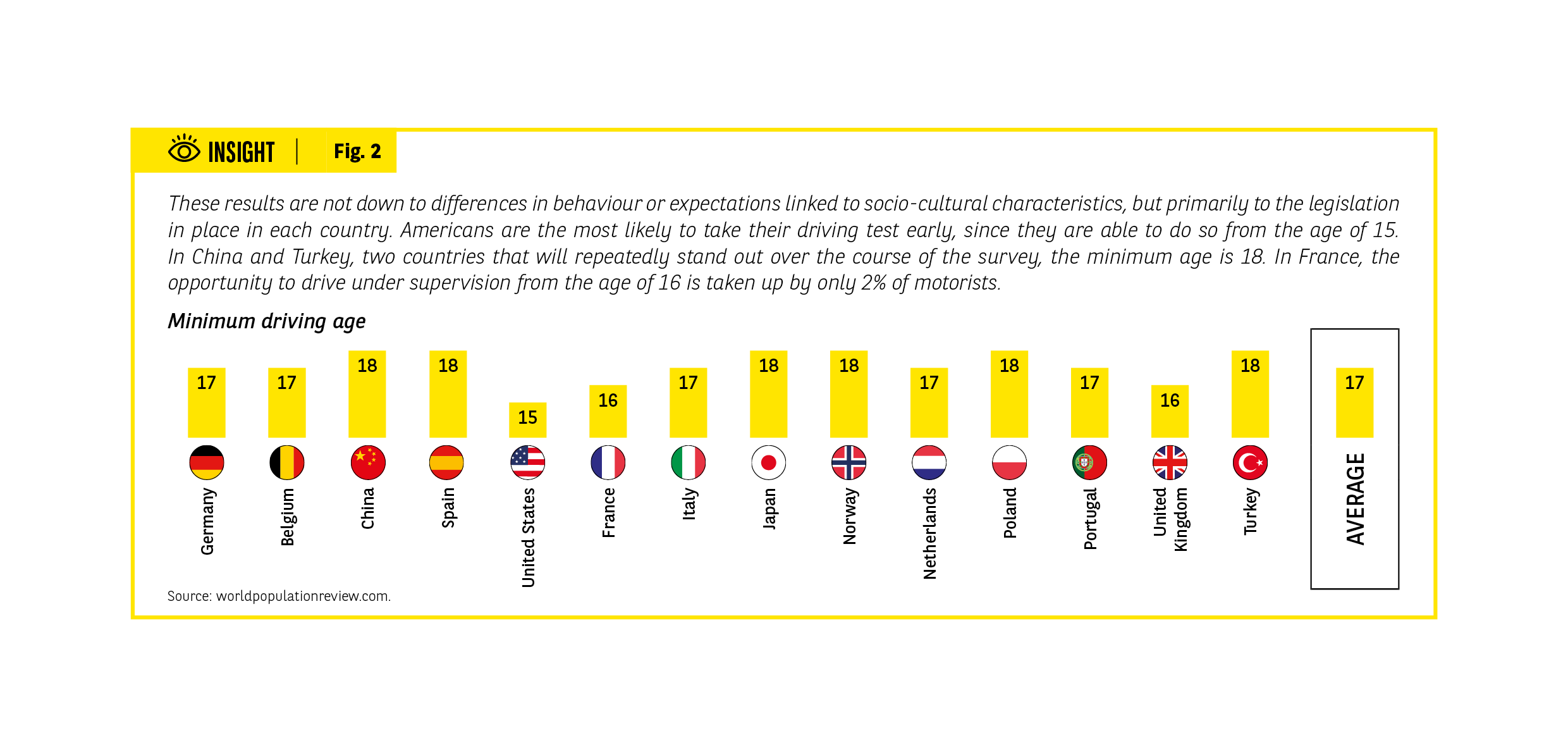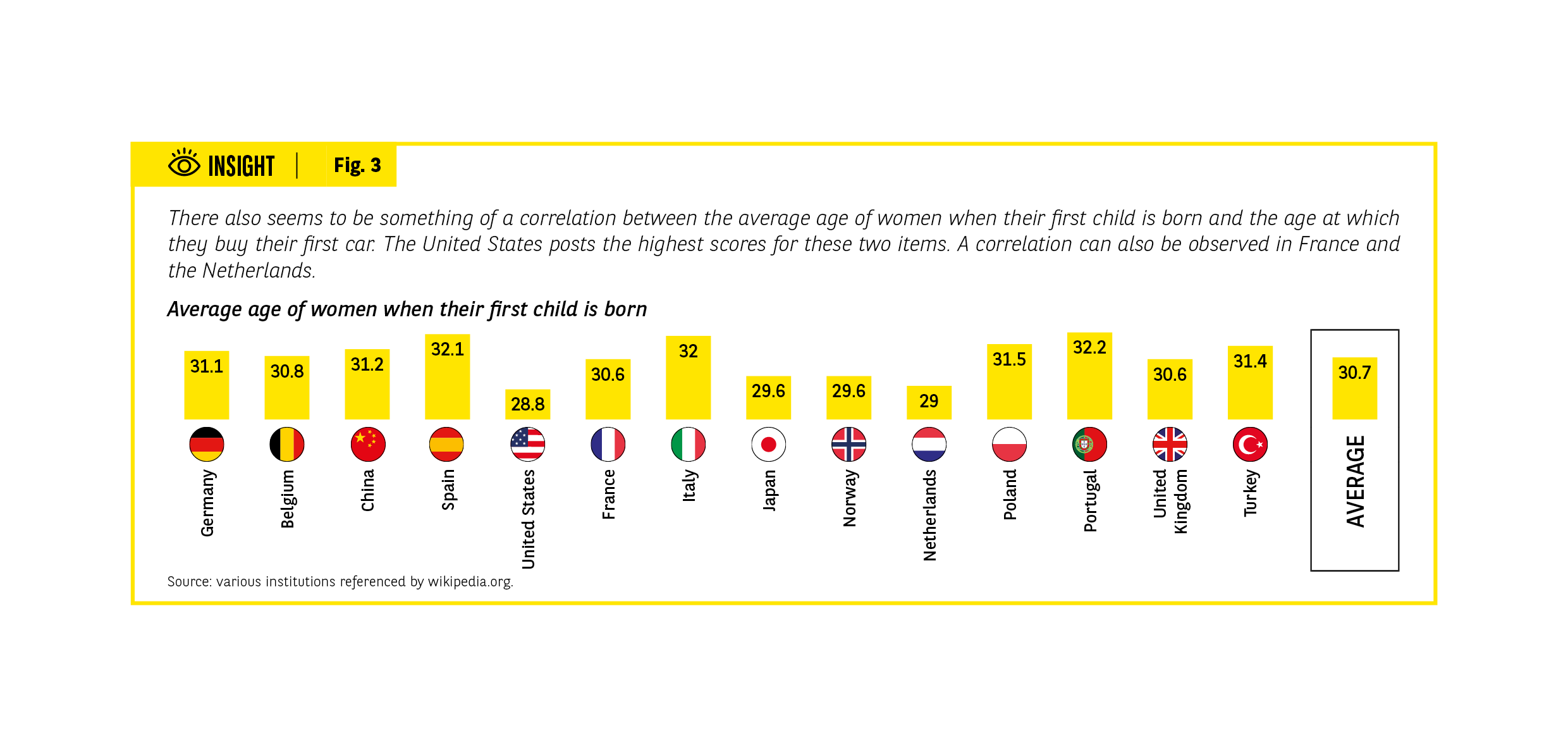A clear desire to drive


Are young people disconnected from the automotive world? Not at all, on the contrary. As soon as they are legally able to do so, they can’t wait to get behind the wheel and they do so with unabashed joy, albeit with varying degrees of financial ease. Cars are seen as the centrepiece of their mobility mix and essential to their daily lives, both now and in the future.
THE YOUNG CAN’T WAIT TO GET THEIR DRIVING LICENCE…
Given their cost and size, cars are rarely considered as products whose purchase alone can bring total satisfaction. Buying a car is great, but using it is even better. However, this is dependent on whether one holds the golden ticket to motoring freedom: a driving licence.
Thus, future drivers tend not to wait until they are no longer young to pass their test. 85% of this population do so before the age of 25. The Chinese are the most likely to fall into the “late adopters” category, with 4 out of 10 passing their test after turning 25. At the other end of the scale, the British, and even more so the Americans, race to pass their driving test as early as possible. Indeed, more than half of US drivers obtain their licence before the age of 18 (Fig. 1).
Fig 1 – Age of obtaining a driver’s license by country
Download this infographic for your presentations Bar chart showing the age of obtaining a driver’s license in several countries. Categories: under 18 (yellow), 18 (light green), 19-20 (green), 21-25 (light blue), over 25 (dark blue).
Main data by country (in percentages):
Germany: 12% under 18, 43% at 18, 21% at 19-20, 25% at 21-25, 11% after 25.
Belgium: 2, 30, 31, 25, 12.
China: 4, 19, 36, 41, 12.
Spain: 2, 38, 27, 23, 12.
United States: 2, 56, 18, 10, 8.
France: 2, 39, 33, 17, 9.
Italy: 3, 52, 32, 10, 6.
Japan: 2, 43, 35, 19, 8.
Norway: 4, 30, 33, 21, 12.
Netherlands: 3, 30, 22, 24, 21.
Poland: 3, 31, 28, 26, 15.
Portugal: 4, 19, 21, 26, 22.
United Kingdom: 1, 15, 26, 35, 23.
Turkey: 7, 31, 26, 21, 15.
Europe: 4, 36, 27, 20, 13.
Overall: 7, 31, 26, 21, 15.
General trend: the driving license is mostly obtained at 18 years old in most European countries, while it is more frequently obtained after 21 years old in some Asian countries like China and Japan.
Bar chart showing the age of obtaining a driver’s license in several countries. Categories: under 18 (yellow), 18 (light green), 19-20 (green), 21-25 (light blue), over 25 (dark blue).
Main data by country (in percentages):
Germany: 12% under 18, 43% at 18, 21% at 19-20, 25% at 21-25, 11% after 25.
Belgium: 2, 30, 31, 25, 12.
China: 4, 19, 36, 41, 12.
Spain: 2, 38, 27, 23, 12.
United States: 2, 56, 18, 10, 8.
France: 2, 39, 33, 17, 9.
Italy: 3, 52, 32, 10, 6.
Japan: 2, 43, 35, 19, 8.
Norway: 4, 30, 33, 21, 12.
Netherlands: 3, 30, 22, 24, 21.
Poland: 3, 31, 28, 26, 15.
Portugal: 4, 19, 21, 26, 22.
United Kingdom: 1, 15, 26, 35, 23.
Turkey: 7, 31, 26, 21, 15.
Europe: 4, 36, 27, 20, 13.
Overall: 7, 31, 26, 21, 15.
General trend: the driving license is mostly obtained at 18 years old in most European countries, while it is more frequently obtained after 21 years old in some Asian countries like China and Japan.
Fig 2 – Minimum legal age for driving by country
Download this infographic for your presentations Comparative graph showing the minimum legal age for driving in different countries. Each country is represented by a flag icon with a number indicating the age in years.
Data by country: Germany: 17 years Belgium: 17 years China: 18 years Spain: 18 years United States: 15 years France: 16 years (accompanied driving) Italy: 17 years Japan: 18 years Norway: 17 years Netherlands: 18 years Poland: 18 years Portugal: 17 years United Kingdom: 16 years Turkey: 18 years Global average: 17 years
Context: the minimum age results mainly from the legal framework specific to each country rather than cultural differences. Americans are more likely to obtain their license earlier because they can start driving at 15 years old. In China and Turkey, access is set at 18 years old. In France, although accompanied driving is possible from 16 years old, only 2% of drivers use it.
Source: worldpopulationreview.com
Comparative graph showing the minimum legal age for driving in different countries. Each country is represented by a flag icon with a number indicating the age in years.
Data by country: Germany: 17 years Belgium: 17 years China: 18 years Spain: 18 years United States: 15 years France: 16 years (accompanied driving) Italy: 17 years Japan: 18 years Norway: 17 years Netherlands: 18 years Poland: 18 years Portugal: 17 years United Kingdom: 16 years Turkey: 18 years Global average: 17 years
Context: the minimum age results mainly from the legal framework specific to each country rather than cultural differences. Americans are more likely to obtain their license earlier because they can start driving at 15 years old. In China and Turkey, access is set at 18 years old. In France, although accompanied driving is possible from 16 years old, only 2% of drivers use it.
Source: worldpopulationreview.com
BUYING ONE’S FIRST CAR: A LOGICAL PROGRESSION
Obviously, the earlier people pass their driving test, the sooner they tend to buy their first car and the keener they are to get behind the wheel quickly. Around 7 out of 10 Americans acquire their first vehicle between the ages of 16 and 20. The same is true for 1 in 2 French, German and Italian motorists. In contrast, 1 in 3 Japanese and Chinese motorists don’t buy a car until they have turned 25.
While being in a relationship is not a determining factor on the whole, geographical location has an altogether greater influence. 1 in 2 under-20s who live in towns of fewer than 20,000 inhabitants have already bought a vehicle.
Fig 3 – Average age of women at the birth of their first child, by country
Download this infographic for your presentations Graph showing the average age of women at the birth of their first child in different countries. Each country is represented by a flag and a number expressed in years.
Data by country:
Germany: 31.1 years
Belgium: 30.8 years
China: 31.2 years
Spain: 32.1 years
United States: 28.8 years
France: 30.6 years
Italy: 32 years
Japan: 29.6 years
Norway: 29.6 years
Netherlands: 29 years
Poland: 31.5 years
Portugal: 32.2 years
United Kingdom: 30.6 years
Turkey: 31.4 years
Global average: 30.7 years
Context: the comparison between the average age at first child and the age of buying a first vehicle reveals convergences, particularly in the United States where both values reach the highest levels. A similar concordance appears in France and the Netherlands.
Source: various institutional sources referenced by wikipedia.org
Graph showing the average age of women at the birth of their first child in different countries. Each country is represented by a flag and a number expressed in years.
Data by country:
Germany: 31.1 years
Belgium: 30.8 years
China: 31.2 years
Spain: 32.1 years
United States: 28.8 years
France: 30.6 years
Italy: 32 years
Japan: 29.6 years
Norway: 29.6 years
Netherlands: 29 years
Poland: 31.5 years
Portugal: 32.2 years
United Kingdom: 30.6 years
Turkey: 31.4 years
Global average: 30.7 years
Context: the comparison between the average age at first child and the age of buying a first vehicle reveals convergences, particularly in the United States where both values reach the highest levels. A similar concordance appears in France and the Netherlands.
Source: various institutional sources referenced by wikipedia.org
